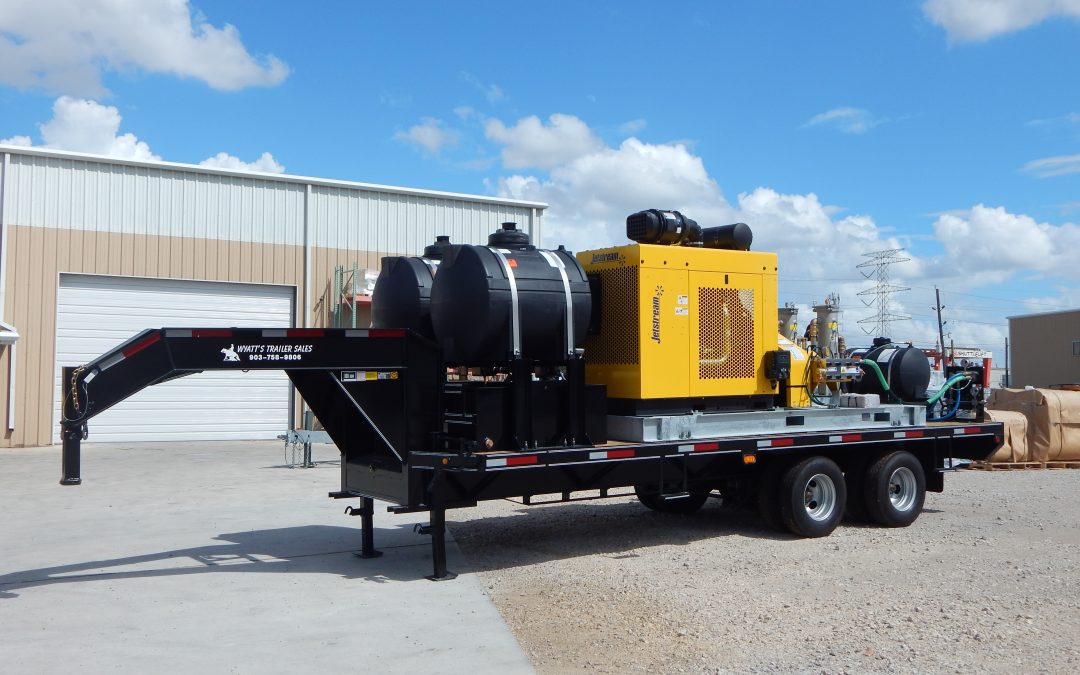Oil and gas rigs are home to volatile equipment. One wrong move can lead to untold damage to the crew, rig and environment. To meet safety requirements, these operations invest in blowout preventer (BOP) testing, which must be completed every one, three or five years according to federal regulations. The contractors who perform hydrostatic testing — or the torque and test — use waterblasting units designed specifically for this process.
Contractors need to be sure that their waterblasting pumps can consistently and quickly hit the required pressure of 1.5 times the maximum allowable working pressure of the blowout preventer system, and they need to do it fast and consistently. That’s where Jetstream comes in. We design durable and efficient waterblasting units for hydrostatic testing, ensuring quality and safety for blowout preventer systems on oil and gas rigs. Plus, with Jetstream, you get reliable performance and peace of mind knowing your equipment meets the highest standards.
Below are a few things to keep in mind while choosing your next hydrostatic testing unit, as well as what to look for in an equipment manufacturer.
Maximize Efficiency
Hydrostatic testing units pressurize the blowout preventer to make sure it is functioning properly. Contractors should look for waterblasting systems that can quickly reach the appropriate flow rate and pressure needs of the test. The faster the pump reaches this flow rate and fills the vessel, the faster the test will go, reducing the shutdown time and maximizing efficiency for the contractor.
To meet the unique demands of this task, Jetstream’s HydroForce™ hydrostatic testing unit can produce between 6,000 psi and 20,000 psi with flow rates ranging from 6 to 60 gallons per minute. The unit can be customized based on operational needs with one of three options for the waterblasting pump: the 3000, 3600 or 4200 Series. In addition to the pump, the HydroForce unit features a bleed-off tank and a control panel where the valves needed for testing are condensed together. It also comes with optional features, like flood lights, Jetstream hydrostatic test valves, hose racks, chart recorders, control stations and more.
The waterblasting pump pulls water from an on-unit water tank and pushes it into the blowout preventer system at the appropriate pressure. The water goes through the test valve, the block, and into the vessel. The unit usually runs for around five minutes before the system is pressurized to 1.5, the maximum allowable working pressure of the vessel. Then, the check valve is closed to trap the water in the vessel and line and a chart recorder records the fluctuations in pressure. When the test is complete, a valve is turned and the water in the system runs into a bleed-off tank. The faster this process is completed, the faster the well can return to operation.

Serviceability
Contractors should look for reliable equipment with proven quality, and a manufacturer that is responsive to customer needs. Without a backlog of spare parts, some manufacturers end up limiting the number of parts customers can buy. At Jetstream, we build our equipment in-house and keep spare parts on hand. Our service centers maintain more than $2 million worth of spare parts in stock. Each time customers put in a parts order, they speak with one of our waterblasting experts, getting premium person-to-person service and support.
Jetstream’s pumps and units are also simple to maintain, making it easy to change out parts while on the job. If you need to change out the pressure of your equipment quickly, our fluid end technology is designed for fast, in-the-field maintenance with valve cartridge changes that take just 15 minutes and packing replacement that can be done in as little as five minutes. Precision engineering and advanced plunger technology means our waterblasting pumps offer long-lasting durability and reliable performance.
Expert Support
At Jetstream, we provide quality equipment and expert advice with a long-standing legacy of safety. The pump and unit used for your hydrostatic testing operation should help reduce downtime and increase speed on the jobsite without sacrificing the quality of the testing service. By working with Jetstream’s team of experts, you can feel confident in your testing process to help keep the oil rig, crew and local ecosystems safe.

